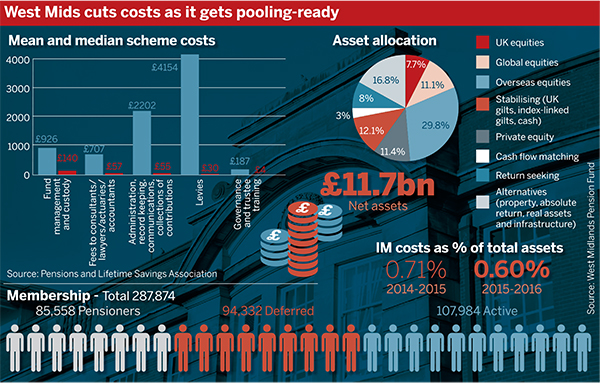The West Midlands Pension Fund has found savings of more than £25m a year after a swath of changes to its investments and a two-pronged strategy to reduce administration costs.
Cost savings have been a major focus for schemes in recent years, particularly for local government schemes; generating cost savings is one of the main objectives of the Local Government Pension Scheme pooling initiative being introduced across England and Wales.
Those with in-house teams have lower average costs, whereas those who outsource have higher costs. If the in-house management is blended, those with lower costs could see them go up
Dave Lyons, Aon Hewitt
The bulk of the savings at the WMPF were made by establishing a £500m in-house global equities portfolio, along with withdrawals from hedge funds and commodities.
In the fund’s most recent annual report, councillor Jasbir Jaspal, chair of the pensions committee for the WMPF, said: “This, along with other changes to the portfolio over the last few years, has yielded ongoing savings of almost £25m per year.”
The global equities portfolio is managed internally and its creation was funded with cash, proceeds from UK equity sales and an in specie transfer – a transfer of ownership of an asset to the scheme.
A spokesperson said the scheme was continuing to review its in-house offering as LGPS pooling proceeds.
The spokesperson said: “We’re excited by the prospect of pooling and the implications it has for us and our partners. Pooling will enable us to access deeper internal resources than at present, which can only be good for the fund and its partners.”
Mark Packham, public sector pensions leader at consultancy PwC, said only a “handful” of funds had built up expertise in managing investments in-house, which would then lead to some of the pools having said expertise once they are fully operational.
“The in-house investment teams operated by individual funds will be moved into [pools] that will then be providing services back to the funds… the in-house investment teams will become very valuable.”
He added that while more than £30bn of the LGPS funds’ £200bn of assets was managed internally, it was unclear how much is being actively or passively managed.
Dave Lyons, head of public sector investment consulting at Aon Hewitt, said schemes with internal resources could face slightly higher costs if they transfer employees into the pool.
“Those with in-house [teams] have lower average costs, whereas those who outsource have higher costs,” he said. “If the in-house [management] is blended, those with lower costs could see [them go up].”
Lyons said members of the Local Pension Partnership pool had already used a transfer of undertakings (protection of employment) transfer, as is relatively common for the public sector, to move in-house teams from the pension scheme to the pool.
However, he added that pools could be structured differently, and so schemes would have to work it out for themselves. “They’re all a little bit different with what they’re starting with and how they’re setting themselves up,” he said.
Admin savings
Alongside the savings from moving investment capabilities in-house and withdrawing from hedge funds and commodities, the fund also found savings through its administration, oversight and governance.
The cost per member reduced to £17.72 annually from £18.70.
The spokesperson said: “Due to tight management of costs throughout the year, including challenging all expenditure to ensure that it was both necessary and represented value for money, significant in-year savings were identified against the budget.”
This strategy, combined with the scheme’s ongoing use of its web portal to communicate with members, saves the scheme roughly £300,000 annually.
Registrations for the portal increased to 41,167 from 23,157 in the year.
“The web portal has delivered both greater choice to our members in terms of how they access information about their pensions, and significant ongoing savings. One of the key benefits… has been making our annual benefit statements available online to view,” the spokesperson said.
“In addition, we have been making pensioner payslips available online since 2014. Both strategies have resulted in savings of approximately £300,000 per year.”














